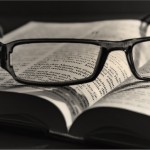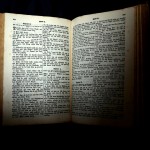Reformed Egyptian (See Part I here)
More problematic in terms of the credibility of Joseph Smith is the evidence of what is commonly known as the “Anthon Transcript,” an alleged transcription of characters taken from the plates of the Book of Mormon housed in the Community of Christ archives. The importance of this document for evaluating Joseph Smith’s claim to have translated an ancient Reformed Egyptian text can hardly be exaggerated. All indications are that the curious symbols on the document originated from Smith, and though there is a long history of LDS apologists who have tried to suggest otherwise, they bear no demonstrable relation to any phase of ancient Egyptian and in fact likely do not represent any discrete humanly-evolved writing system at all.
Recent research on the Community of Christ document has shed considerable light on its origin and background. We now know that the document is not the transcript taken to Professor Anthon by Harris, but is a later copy of Book of Mormon characters made by either Christian or John Whitmer. Based on a photo discovered by Johnny Stephenson in the Clay County Museum the document is actually a fragment of what had been a larger document containing a line from the Joseph Smith translation of Genesis. At the bottom of the page and perpendicular to the characters we read, “The Book of the Generations of Adam,” a quote from the Book of Moses 6:8. [1] The inclusion of this text is significant and provides additional material with which to clarify the document’s origin and authorship. According to the analysis of Brent and Erin Metcalfe the handwriting of both the line from the Book of Moses and the sample of Book of Mormon characters corresponds to the 3rd (until recently unidentified) scribe of the original Book of Mormon manuscript, now established to be Christian Whitmer. [2] In addition to helping to identify the author of the ‘Caractors’ document, the reference to the Book of Moses also points to the general context in which it may have been produced, namely, the activities of John Whitmer as church historian before he relocated to Missouri in 1831. John Whitmer had been heavily involved in gathering and copying church documents, including the Genesis revision, and when he was sent to Zion to assist in the publication of the Book of Commandments, he brought a personal copy of the Genesis revision with him. This historical setting would explain among other things the rationale for making a separate copy of Book of Mormon characters, the connection to the Genesis revision present in the document, and why the manuscript was kept as an exclusive possession of the Whitmer family, being passed down from John Whitmer to David Whitmer. [3]
We now also know that the Whitmer ‘Caractors’ document was not the only copy of Book of Mormon characters used by early Mormons, but that there were several transcripts of Reformed Egyptian in circulation. Aside from the form preserved in the Whitmer document, there are two other character traditions presently known, including a three-line transcript published both in The Prophet by Samuel Brannan and a broadside promoting the Book of Mormon called the ‘Stick of Joseph’ in 1844 and another three line transcript found by Brent and Erin Metcalfe in a 19th century journal. [4] Careful examination and comparison of the three transcript traditions allows for several preliminary observations:
First, the various character traditions are closely related, showing a high degree of similarity in their representation of Reformed Egyptian characters and their arrangement into a continuous sequence. In fact, the first three lines of the Whitmer document conform very nearly to the two other traditions, suggesting a common authorial origin and that they are relatively faithful reproductions of what Joseph Smith claimed to be the language found on the plates.
Second, despite the high degree of agreement and repetition among the various transcript traditions, there are small but perceptible variations in detail in the three lines shared by all the samples, showing that they are not merely copies of a common underlying source but are independent textual traditions with their own unique histories. For example, by my count the Whitmer transcript and the transcript published in The Prophet and the ‘Stick of Joseph’ broadside share about 60 characters or signs that are found in basically the same order. But in the context of this general overlapping of traditions the Whitmer transcript has 3 characters at the end of the third line unique to that tradition, whereas the version in the The Prophet has 4 unique characters present at the end of the first and third lines. In addition, 14 of the characters shared between the two transcripts are not fully identical, but manifest slight variations in shape and form, to such a degree that at least some of them can be assumed to have originated that way and are not to be explained as simple copying errors.
Third, the Whitmer ‘Caractors’ document is actually a composite text containing two separate Book of Mormon character traditions. Not only is the long seven-line transcript out of step with the other three-line transcripts, but the document divides rather naturally into two sections, the first four lines and the last three lines: 1) The size of the characters in the two sections are distinct, with all of the characters in the last three lines being written in smaller handwriting. 2) The second section contains at least 30 new characters not encountered in the first section or in the other Reformed Egyptian transcripts, thus setting it apart from all other character traditions. 3) The second portion is distinguished by an enigmatic dash (-) appearing at regular intervals and which apparently divides up the characters into groups or sequences. 4) The fourth line of the first section ends before having reached the end of the line and with extra space to spare for the writing of additional characters. The fact that no characters from the second portion were written here suggests that the latter were added separately from the first three lines as one continuous block. [5]
Other evidence for the existence of multiple Reformed Egyptian character traditions used by early Mormons is preserved only in literary sources that refer to them. As is well known, Professor Anthon’s description of the document presented to him by Martin Harris differs markedly from the Whitmer transcript and the other character traditions mentioned above. According to Anthon’s 1834 account, “This paper was in fact a singular scrawl. It consisted of all kinds of crooked characters disposed in columns, and had evidently been prepared by some person who had before him at the time a book containing various alphabets. Greek and Hebrew letters, crosses and flourishes, Roman letters inverted or placed sideways, were arranged in perpendicular columns, and the whole ended in a rude delineation of a circle,” which he thought to be a representation of the Mexican calendar. Later in 1841 Anthon essentially repeats this description of the layout and form of the document only adding a few additional details: “The characters were arranged in columns, like the Chinese mode of writing, and presented the most singular medley that I ever beheld. Greek, Hebrew and all sorts of letters, more or less distorted, either through unskilfulness or from actual design, were intermingled with sundry delineations of half moons, stars, and other natural objects, and the whole ended in a rude representation of the Mexican zodiac.”
Although Anthon’s interpretation and identification of the various elements he saw in the document may be questioned, there can be little doubt because of the consistency of his testimony over a span of several years that he was attempting to accurately describe the content of the document as he remembered it. His reference to a peculiar and idiosyncratic assortment of alphabetic characters, “more or less distorted,” immediately calls to mind the mixture of symbols we find in available Book of Mormon character traditions. Furthermore, we have later recollections from knowledgeable informants that tend to substantiate Anthon’s claim that the document shown by Harris included some unusual symbols and shapes and would also perhaps account for its exceptional columular structure, including a report by Orsamus Turner that Harris had once exhibited the title page of the plates of the Book of Mormon and “on it was drawn, rudely and bunglingly, concentric circles, between above and below which were characters, with little resemblance to letters” (History of the Pioneer Settlement, 1851). Fayette Lapham remembered that Joseph Smith Sr. had told him that inside the plates “were representations of all the masonic implements, as used by masons at the present day” and that “the remaining pages were closely written over in characters of some unknown tongue, the last containing the alphabet of this unknown language” (Historical Magazine, 1870), Finally, Lucy Mack Smith more than once characterized the document taken by Harris to the East as containing an “alphabet” of Reformed Egyptian characters. [7] Harmonizing these various statements, it is possible that the document taken by Harris to Anthon was a copy of the last page of the Book of Mormon and that it contained, among other things, an alphabet of the Nephite language, which would explain why it was arranged so differently from the other character traditions.
In addition to the transcript taken to Anthon now lost, we have a few other references to Reformed Egyptian transcripts that can possibly be correlated with one or more of the above mentioned character traditions. John A. Clark, a minister from Palmyra, recalled that in the Fall of 1828 Martin Harris had visited him and shown “a slip of paper, which contained three or four lines of characters, as unlike letters or hieroglyphics of any sort…” (Gleanings by the Way, 1842). Based on his description, this sample of Book of Mormon Egyptian may have been the source behind either the four line tradition found at the top of the Whitmer transcript or the three line tradition found in The Prophet or the private journal insertion found by Brent and Erin Metcalfe. Or, less likely, it could be an entirely independent tradition. Furthermore, we know that Joseph Smith kept his own copy of Book of Mormon characters independent of the Whitmer transcript, since we have reports of him showing a sample of Reformed Egyptian to curious visitors both in Kirtland and Nauvoo. [8] Again, this particular character tradition associated with Joseph Smith may be identifiable with the version eventually published by the church in The Prophet and the ‘Stick of Joseph’ broadside after Joseph Smith’s death.
In sum, we can conclude that there were multiple traditions of Book of Mormon characters in circulation in the early church and that all known versions are actually copies of alleged copies. We do not have the original transcript that Harris showed to Anthon, though it is likely that many of the same characters that appear on the Whitmer and other transcripts were featured in it.
Nevertheless, despite the essentially secondary nature of the extant Book of Mormon character traditions, we can be confident in assuming that they are reliable copies of sources whose common point of origin was Joseph Smith. This is because 1) the overwhelming agreement of the transcripts in their depiction of Reformed Egyptian is most conducive to a theory of unified origin/authorship. 2) During the translation process Smith was the only person who claimed to have access to the plates and could read them, which means that only he could have been the source of the original transcripts. 2) Various early accounts support this conclusion and portray Smith drawing up copies, sometimes with the help of others: “the aforementioned Mr Martin Harris came to our place, got the characters which I had drawn off of the plates” (1838 History).[9] 3) At least one of the character transcripts is known to have belonged to someone who functioned as one of Smith’s scribes during the translation/dictation of the Book of Mormon, implying that he would have been a knowledgeable source for what Smith claimed to be Reformed Egyptian. 4) The characters on the various transcripts closely resemble what were later identified as Book of Mormon hieroglyphs in a document prepared by Oliver Cowdery and Frederick G. Williams in Kirtland under the direction of Smith. The characters are also recognizably analogous to the pseudo-Egyptian characters restored by Smith to parts of the Book of Abraham papyri that had flaked away. [9] 5) As was mentioned above, Smith continued to show a copy of the characters to interested non-LDS observers, indicating his support for the authenticity of the Reformed Egyptian tradition at a fairly late period.
It is at this point, however, that we begin to run into the problem of the linguistic origin of the characters. Although Smith seems to have repeatedly taught his followers that the characters were transcriptions of the language found on the plates and thus a form of ancient Nephite Egyptian, as has been long recognized, the characters bear no recognizable relation to any phase of this language, including Hieratic or Demotic. There is no consistent pattern of morphological or structural features indicative of an Egyptian derivation and the repetition of free characters in a long unbroken row is also manifestly un-Egyptian in character. Although isolated correspondences between Demotic and individual characters on the transcripts have sometimes been noted by amateur Mormon Studies enthusiasts, the similarities are actually arbitrary and as such completely meaningless. One could potentially find the same kinds of correspondences with many different scripts the world over, including English.
LDS apologists have been aware of the general lack of correspondence between the Book of Mormon characters and any known Egyptian script and so have offered two precautionary arguments to make this discrepancy intelligible. The first has to do with the nature of the script itself and the fact that if the characters are indeed authentic, they would therefore stem from the latest period of ancient Nephite civilization. As John Gee explains, “If this is the copy of the characters that was taken to Anthon, then it comes from the part of the Book of Mormon that was translated while Martin Harris was the scribe, and thus is from the missing 116 pages. If this were the case, we should expect it to be from Mormon’s abridgment of the Nephite record (see Words of Mormon 1:3–7; D&C 10:30, 38–42). This would mean that it would be from the handwriting of Mormon (after ca. A.D. 362; see Mormon 3:8–11) and not from the small plates. We would then expect it to be a Semitic language written in an Egyptian script—a Semitic language that had been modified by time and creolization with the American languages, and an Egyptian script that had been modified not only by being engraved on metal plates, but also changed along with the handwriting styles and modifications of the Nephites (see Mormon 9:32).” [10]
But this line of reasoning is problematic for several reasons. First, the Book of Mormon itself denominates the language in which it was written as Reformed Egyptian, so we would still expect there to be a connection between this language and attested Egyptian writing or to find a substrate of Egyptian features, even if the script had developed from its original shape and form. Second, the evolution of scripts throughout history has tended to be slow and gradual, characterized by a strong tendency to preserve earlier phases of script development. Even when radical development has occurred as a result of a script being modified for the expression of a different/new language, the preservation of major elements of the parent script has been the norm. For example, it is not difficult to see that ancient Greeks borrowed what was originally a Phoenician alphabet, the Japanese borrowed Chinese characters, and Spanish colonialists wrote the Mixtec language of central Mexico using Latin characters [11]. Third, the history of Nephite culture as recounted in the Book of Mormon challenges the assumption that their written language dramatically evolved from its origins. According to the Book of Mormon narrative, the Brass Plates, which were written in the language of the Egyptians and brought to the New World in order to preserve the language of the fathers and earlier Old Testament scripture, were used by scribes and prophets throughout Nephite history (1 Nephi 5:19; 2 Nephi 5:12; Mosiah 1:3-5; Alma 37:1-3; 3 Nephi 1:2, 10:17). Assuming that this representation is accurate, we would expect for this written tradition to have functioned as a constraining influence on the development of Nephite script, not for the characters used at the end of Nephite history to be utterly different from those at the beginning. Fourth, we have no evidence from within the Book of Mormon that the Nephite culture had any contact with or adopted local American languages and thus no apparent rationale for why the script was modified. In fact, the Book of Mormon narrative indicates that the adoption of Egyptian as a written language was a heritage of the Old World and that Nephite authors altered it at some point purely because of internal development of their speech (Mormon 9:32).
A secondary argument sometimes made by apologists is that the Book of Mormon characters may have been copied poorly or erroneously by Joseph Smith or others, accounting for some of the strange shapes and forms. But even if we agreed that Joseph Smith was liable to make some mistakes in the process of transcription because of his unfamiliarity with the original language on the plates, this alone would not be able to explain the non-Egyptian linguistic profile of the characters as a whole. Furthermore, we have various statements that Joseph Smith took great care in the process of producing his transcriptions. David Whitmer onced reported that the transcript in his possession “took Joseph Smith a whole week to copy, so particular was he that the characters should be perfectly reproduced and that the ‘reformed Egyptian’ language should be shown up in all its native simplicity, for, it must not be forgotten, there was a singular significance in errand which this scrap of paper was destined to perform” (The Daily Inter Ocean, Oct 17, 1886). Joseph Knight similarly recounted, “He now Began to be anxious to git them translated he therefore with his wife Drew of the Caricters exactley like the ancient and sent Martin Harris to see if he Could git them Translated” (Reminiscences, 1833-1847). Finally, the strong uniformity of the various character traditions supports the assumption that they are fairly accurate renderings of what Joseph Smith claimed to be Reformed Egyptian. More often than not a character on one transcript is nearly identical to its counterpart on the other transcripts. This suggests that whoever made the later copies did so with great care, in order to preserve what must have been regarded as sacred writing.
We can go further however. Not only do Joseph Smith’s transcripts of so-called Reformed Egyptian have no real connection to ancient Egyptian, but they are unlikely to represent any humanly-evolved writing system at all. This is because the several lines of symbols on the transcripts have anomalous features that set them apart from virtually all known functional scripts and others that mark the characters as a modern artificial construct.
First, the characters have an extreme heterogeneity of shape and form. Comparative analysis shows that writing systems that have developed over a long period of time tend to be characterized by a high degree of structural homogeneity and morphological patterning. These scripts typically feature a repertoire of marks and strokes constructing individual characters that formally cohere and identify them as belonging to a particular visual notation system. One need not be an expert in comparative linguistics to note the angular box-like qualities of epigraphic Greek, the criss-crossing and perpendicular joins of ancient Hebrew, the thick pictographic shapes of hieroglyphic Egyptian, the cursive combined with repeated vertical and diagonal strokes of Demotic, the geometric shapes of South Arabian, and the distinctive cursive and joining of Arabic. However, in contrast to these other scripts, the Book of Mormon characters represent a hodgepodge of shapes and forms, including straight strokes, curlicues, and a variety of curves and angles, moving haphazardly in almost all directions.
Second, excessively complex characters are interspersed among simple characters. Comparative study again suggests that over time writing systems are under selective pressure to be relatively easy to read and write. For example, Mark Changizi and Shinsuke Shimojo have examined over 100 language systems spread over human history and concluded that the average number of strokes per characters is approximately three, independent of the number of characters in the writing system. [12] While it is clear that some language systems used a greater number of strokes in the construction of linguistic signs and could persist in a more complex form, the Reformed Egyptian of the transcripts is nevertheless unique in its juxtaposition and seemingly random distribution of unusually complicated characters, some requiring up to ten strokes, among a variety of two or three stroke characters.
Third, a large number of characters have unmistakable resemblances to English letters and numerals, as many others have noted. The letters and numbers, however, are generally deformed, truncated, turned on their side/upside down, or given curlicues. By my count, out of the 200 characters that appear on the Whitmer transcript as many as 150 could be plausibly understood as having been adapted from these well-known and obviously modern symbols. Although some have argued that many characters have a close relation to varieties of English shorthand used during the 17-19th centuries, I think an even better explanation is that of Dan Vogel who shows that the majority of characters could have been invented by Joseph Smith on the spot. [13]
Finally, small variations in the sequencing and representation of the characters among the various transcripts are consistent with an understanding of the Reformed Egyptian language as an artificial creation of a modern author. As was already mentioned earlier, the first three lines of the Whitmer transcript and the other three-line transcripts clearly diverge in their repertoire of signs, with the unique characters in each tradition falling at the ends of the lines at the right hand side of the page. This variation in detail is striking and suggests that the characters were not placed so as to construct a meaningful sequence, but were positioned rather haphazardly in order to fill out the page. In addition, the small differences in the representation of certain characters across the character traditions, at least some of which are not easily explained as copying errors because of the strength of their divergence and individuality, is further corroboration that the author of the characters was engaged in linguistic artifice. Because the author was not in fact copying from a manuscript source but was inventing the characters through personal imagination and wit, this made him prone to occasionally write characters differently on different versions of the character transcripts.
In conclusion, careful study of the historical background and linguistic profile of the Book of Mormon characters on the Whitmer and other character transcripts demonstrates that they were not likely ever used as a functional script of a living language, but were artificially developed in modern times in order to give the appearance of an ancient hieroglyphic-like language. Because Joseph Smith was the only person who claimed direct access to the plates and reports depict as having drawn off the characters, we must assume that he was the one responsible for creating them in the first place. Apparently, the main resources he had at hand were fairly limited, including a very vague image of Egyptian hieroglyphics and Mesoamerican pictographs, following the popular tendency of the time to connect the two, and the idea that English letters and numbers and perhaps some other symbols could provide a base of signs from which to create his Reformed Egyptian characters.
Acceptance of this conclusion is, of course, uncomfortable and sits in tension with traditional orthodox belief. I myself was long hesitant to come to it, because it upsets the commonly accepted narrative about the how the Book of Mormon came to be and points to the need for reevaluating, or at least reinterpreting, many of Joseph Smith’s supernatural claims. If Joseph Smith was able to construct a false language in order to lend legitimacy to his story about the golden plates, then what else did he contrive? What other stories did he invent? What were his goals and intentions with these stories? Which probably goes a long way in explaining why orthodox LDS scholars for the last few decades have tended to avoid examining or publishing on the Reformed Egyptian character transcripts in any rigorous or critical way. But as uncomfortable as it may be the character transcripts are without a doubt some of the strongest material evidence remaining from the early days of the church that Joseph Smith consciously engaged in deception in his establishment of the Mormon Restoration movement.
[1] For a photo of the complete document, see Johnny Stephenson’s blog Mormonite Musings here.
[2] According to reports of Brent and Erin Metcalfe’s presentation at the 2013 John Whitmer Historical Association meeting and personal communication from Brent Metcalfe. See also Michael Hubbard MacKay, Gerrit J. Dirkmaat, and Robin Scott Jenson, “The ‘Caractors’ Document: New Light on an Early Transcription of the Book of Mormon Characters,” Mormon Historical Studies 14 (2013): 131-52.
[3] Johnny Stephenson traces what can be known about the owners of the Whitmer transcript here.
[4] Personal communication from Brent Metcalfe. For images of the broadside and the transcript published in The Prophet, see here.
[5] Compare Dan Vogel, “Book of Mormon Characters Examined”.
[6] Lucy Mack Smith, History, 1844-1845. See also Johnny Stephenson’s discussion here.
[7] Including Michael Chandler at Kirtland and George Moore and an anonymous “Gentile” in Nauvoo. See Johnny Stephenson’s discussion here.
[8] See also “Questions proposed to the Mormonite Preachers and their answers obtained before the whole assembly at Julian Hall, Sunday Evening, August 5, 1832,” Boston Investigator, Aug 10, 1832, containing responses by Samuel Smith and Orson Hyde: “Q. – By whom was a fac simile of some part of the language and characters taken, and on what material. A. – It was taken by Joseph Smith on paper from the original plates themselves.”
[9] Edward H. Ashment, “‘A Record in the Language of My Father’: Evidence of Ancient Egyptian and Hebrew in the Book of Mormon” in New Approaches to the Book of Mormon (ed. Brent L. Metcalfe; Signature Books, 1993), 336.
[10] John Gee, “Some Notes on the Anthon Transcript,” FARMS Review of Books 12 (2000): 7-8.
[11] For discussion of radical or systemic script change, see Richard Salomone, “Some Principles and Patterns of Script Change” in The Shape of Script: How and Why Writing Systems Change (ed. Stephen D. Houston; SAR Press, 2012), 126-131.
[12] Mark Changizi and Shinsuke Shimojo, “Character Complexity and Redundancy in Writing Systems over Human History,” Proc. R. Soc. B 272 (2005): 267-275.
[13] Dan Vogel, How Joseph Smith Invented Reformed Egyptian.











